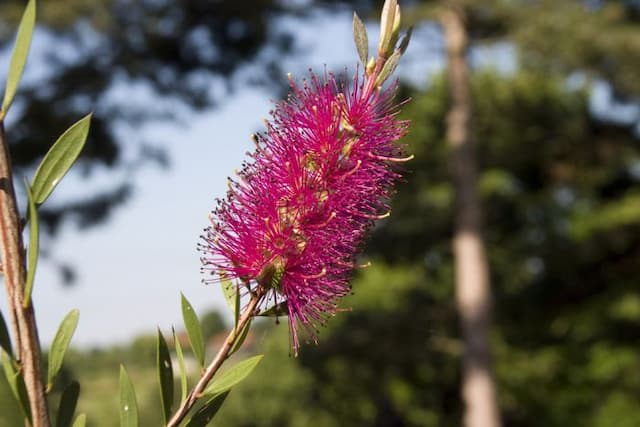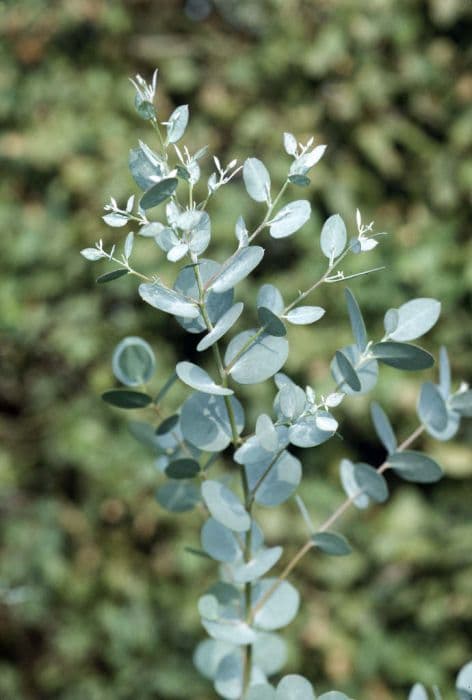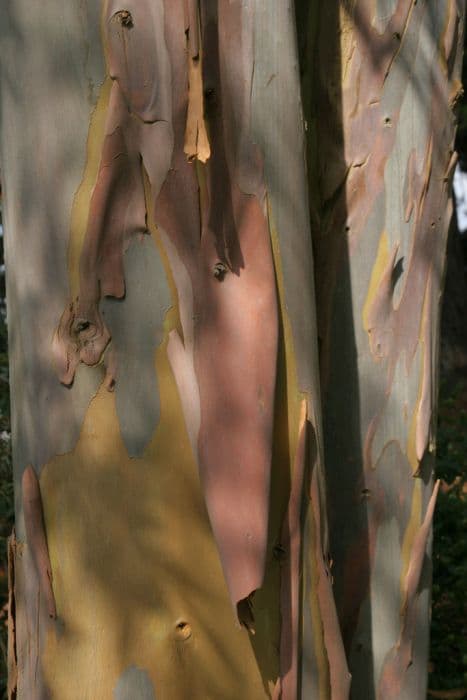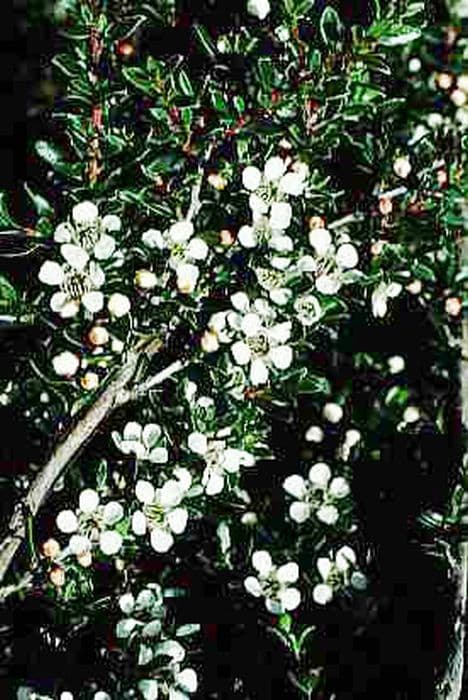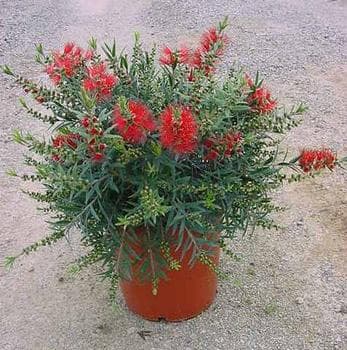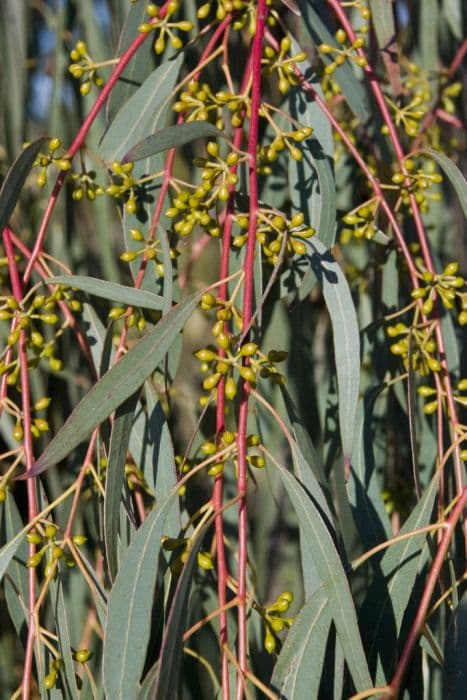Bottlebrush Callistemon viminalis Hot Pink = 'Kkho1' (PBR)

ABOUT
The Callistemon viminalis Hot Pink, commonly known as the Pink Weeping Bottlebrush, is a vibrant and visually striking plant. It is renowned for its flamboyant flower displays that produce hot pink, brush-like blooms. These flowers are very attractive to birds and beneficial insects, providing a valuable source of nectar. The blooms are made up of numerous filamentous stamens, which give them a bristly appearance that resembles the shape of a traditional bottle brush, hence the common name. The leaves of this Bottlebrush are narrow, lance-shaped, and exhibit a leathery texture with a slightly pendulous or weeping habit, giving the plant a graceful presence. The foliage is typically a bright green, which contrasts beautifully with the hot pink flowers, enhancing the overall display of color. The leaves are evergreen, ensuring that the plant provides visual interest throughout the year. In terms of its growth pattern, the Pink Weeping Bottlebrush displays a bushy and spreading habit with arching branches that contribute to its weeping form. While the flowers are the main highlight, the bark of the plant is also noteworthy; it is often a rough texture and can have a flaky or peeling appearance, adding another layer of textural contrast to the plant. Overall, the Pink Weeping Bottlebrush is a lush and colorful addition to any garden setting, delivering a stunning show of hot pink blooms that are sure to captivate and delight observers.
About this plant
 Names
NamesFamily
Myrtaceae
Synonyms
Weeping Bottlebrush, Hot Pink Bottlebrush
Common names
Callistemon viminalis 'Hot Pink'.
 Toxicity
ToxicityTo humans
The plant commonly known as Bottlebrush 'Hot Pink' (Callistemon viminalis 'Kkho1' PBR), is not widely known to be toxic to humans. However, as with any plant material, individual sensitivities can vary, and consumption of non-food plants is generally not advisable. If ingested, it could potentially cause mild stomach upset due to the unfamiliarity of plant material in the human diet, but there are no well-documented toxic effects directly associated with this particular variety of bottlebrush in humans. It should be noted that care should be taken to avoid contact with the eyes and prolonged skin contact, as this can sometimes lead to irritation due to the physical structure of the plant or plant saps.
To pets
The plant commonly known as Bottlebrush 'Hot Pink' (Callistemon viminalis 'Kkho1' PBR), is not known to be toxic to pets such as dogs and cats. It does not appear on common lists of plants that are poisonous to pets provided by various pet health and safety organizations. Therefore, it is unlikely to cause severe toxicity if pets ingest parts of this plant. Nevertheless, ingestion of non-food plant material can possibly result in mild gastrointestinal upset in some animals. Symptoms could include vomiting or diarrhea, which typically result from the ingestion of unusual plant material rather than a specific toxin. If a pet were to display such symptoms after ingesting parts of the bottlebrush 'Hot Pink', it is prudent to consult with a veterinarian.
 Characteristics
CharacteristicsLife cycle
Perennials
Foliage type
Evergreen
Color of leaves
Green
Flower color
Pink
Height
10 feet (3 meters)
Spread
6 feet (1.8 meters)
Plant type
Shrub
Hardiness zones
9
Native area
Australia
Benefits
 General Benefits
General Benefits- Attractive Flowers: The 'Kkho1' variety, also known as Bottlebrush, is known for its vibrant hot pink flowers that add a pop of color to gardens.
- Wildlife Attraction: Its colorful blossoms attract various pollinators including birds, bees, and butterflies, enhancing the biodiversity of the area.
- Drought Tolerance: Once established, Bottlebrush is relatively drought-resistant, making it suitable for water-wise landscapes.
- Low Maintenance: It requires minimal pruning and can thrive in a range of soil types, reducing the need for constant care.
- Adaptability: The Bottlebrush is adaptable to different conditions and can be grown in a variety of climates, from coastal to inland areas.
- Decorative Uses: Due to its unique floral display, it is often used in ornamental gardens and as a feature plant in landscapes.
- Erosion Control: Its root system helps to stabilize the soil, making it a good choice for slopes or areas prone to erosion.
- Hedge or Screen Planting: With its dense growth habit, Bottlebrush can be used for creating privacy screens or hedges.
- Long Flowering Period: This plant has a prolonged flowering season, which ensures a long-lasting display of color in the garden.
- Container Gardening: Bottlebrush can be grown in containers making it suitable for patios and balconies where ground planting isn't possible.
 Medical Properties
Medical PropertiesThis plant is not used for medical purposes.
 Air-purifying Qualities
Air-purifying QualitiesThis plant is not specifically known for air purifying qualities.
 Other Uses
Other Uses- Art and Craft Material: The vibrant pink blooms of the Bottlebrush can be used in dried floral arrangements, wreaths, or as a natural dye for fabrics, providing a touch of color and organic texture.
- Photography Subject: Its striking hot pink flowers make the Bottlebrush a popular subject for photographers and artists, particularly in garden and nature macro photography.
- Educational Tool: Due to its unique morphology, the Bottlebrush can be used in educational settings to teach about plant anatomy and pollination strategies.
- Insect Habitat: By planting Bottlebrush, one can provide a habitat for beneficial insects, and contribute to biodiversity conservation in garden ecosystems.
- Soil Erosion Control: The root system of Callistemon viminalis can help stabilize soils on slopes or in areas prone to erosion, thanks to its ability to form dense thickets.
- Screening Plants: Because they can grow densely, Bottlebrush plants are often used as natural privacy screens in landscaping and garden designs.
- Theme Gardens: The Bottlebrush can be a centerpiece in theme gardens, such as a pink garden theme, attracting visitors and creating a visually cohesive look.
- Windbreaks: Their robust nature enables them to be planted as windbreaks to protect more delicate plants or to reduce wind speed near living areas.
- Sound Barrier: When planted strategically in mass, Bottlebrush hedges can act as a natural sound barrier, reducing traffic or neighborhood noise.
- Culinary Garnish: Although not widely recognized for culinary uses, the vibrant flowers could potentially be used as an ornamental garnish for dishes in adventurous gourmet presentations.
Interesting Facts
 Feng Shui
Feng ShuiThe Bottlebrush is not used in Feng Shui practice.
 Zodiac Sign Compitability
Zodiac Sign CompitabilityThe Bottlebrush is not used in astrology practice.
 Plant Symbolism
Plant Symbolism- Endurance and Survival: Callistemon viminalis, commonly known as the Bottlebrush due to its distinctive brush-like flowers, is a hardy plant that can withstand tough conditions, symbolizing one's ability to endure adversity and persist through challenges.
- Resilience: Its strong and resilient nature, able to regrow after being cut back or affected by natural events, represents resilience and the capacity to rebound from setbacks.
- Rejuvenation: The Bottlebrush is known for its vibrant pink flowers that bloom anew each season, symbolizing rejuvenation and the idea of new beginnings or a fresh start.
- Protection: Traditionally, some cultures believed that the Bottlebrush has protective qualities, representing a guardian or a shield against harm.
- Attraction: With its bright, colorful flowers, the Bottlebrush is a magnet for birds and insects, symbolizing attraction and the ability to draw in what one desires.
 Water
WaterThe Bottlebrush 'Hot Pink' should be watered thoroughly, ensuring the soil is moist but not waterlogged. During active growth in the spring and summer, water approximately once a week with about 1 inch of water. In cooler seasons, reduce the frequency to every two to three weeks, depending on local weather conditions and soil type. It's important to allow the topsoil to dry out slightly before the next watering. Over-watering can lead to root rot, so adjust your schedule as necessary to avoid excess moisture.
 Light
LightBottlebrush 'Hot Pink' thrives in full sun conditions, requiring at least six hours of direct sunlight daily to develop its vibrant blooms and healthy growth. It's best situated in a spot where it can receive ample morning sunlight and some partial shade in the afternoon, especially in very hot climates, to prevent leaf scorch.
 Temperature
TemperatureThe ideal growing temperatures for the Bottlebrush 'Hot Pink' range from 50 to 90 degrees Fahrenheit. While this plant can tolerate minimum temperatures down to about 20 degrees Fahrenheit for short periods, frost can damage the foliage and flowers. The optimal temperature for growth and flowering lies between 65 and 75 degrees Fahrenheit.
 Pruning
PruningPrune the Bottlebrush 'Hot Pink' to maintain shape and encourage bushier growth, removing any dead or diseased branches and spent flowers. Pruning should be done after flowering has finished, usually in late spring or early summer. Light pruning can be done as needed throughout the year to tidy up the plant.
 Cleaning
CleaningAs needed
 Soil
SoilThe Bottlebrush 'Kkho1' thrives in well-draining, loamy soil with a pH range of 5.5-6.5. A mix with peat, compost, and perlite is ideal for this plant.
 Repotting
RepottingBottlebrush 'Kkho1' should be repotted every 2-3 years or when it outgrows its current pot, to ensure healthy growth.
 Humidity & Misting
Humidity & MistingBottlebrush 'Kkho1' prefers moderate humidity levels, not too dry or overly humid; a range of 40-60% is suitable for this plant.
 Suitable locations
Suitable locationsIndoor
Place in bright, indirect light and avoid overwatering.
Outdoor
Full sun exposure and protect from frost.
Hardiness zone
9-11 USDA
 Life cycle
Life cycleCallistemon viminalis Hot Pink 'Kkho1', commonly known as Hot Pink Bottlebrush, begins its life cycle as a seed, which requires well-drained soil and warm temperatures to germinate. Once sprouted, it enters a juvenile growth phase characterized by rapid vegetative development where it establishes its foliage and root system. As it matures, it enters the flowering stage, usually in late spring to early summer, during which bright pink, brush-like inflorescences emerge, attracting pollinators and sometimes leading to seed production. After the flowering period, the plant enters a phase of growth and maintenance, where it continues to develop new leaves and branches while dropping old ones. In favorable conditions, Callistemon viminalis Hot Pink 'Kkho1' can live for many years, potentially reaching a shrub or small tree form. As an evergreen, throughout its life cycle, it retains most of its leaves year-round, barring any environmental stress that may cause leaf drop.
 Propogation
PropogationPropogation time
Spring-Early Summer
Callistemon viminalis 'Hot Pink', commonly known as Bottlebrush, is most effectively propagated using semi-hardwood cuttings. This method involves taking cuttings from the current season's growth that has begun to mature but is not yet fully hardwood. The ideal time for this is late summer to early fall. Cuttings should be about 4 to 6 inches (10 to 15 centimeters) long and include several leaf nodes. Leaves on the lower half of the cutting are removed, and the base is dipped in rooting hormone to promote root development. The prepared cuttings are then inserted into a well-draining potting mix or a propagation medium, ensuring that at least one or two nodes are buried where the roots will form. The cuttings need a warm, humid environment to root successfully, which can be created by covering the pot with a plastic bag or placing it in a propagator. After several weeks to months, when the cuttings have rooted and show new growth, they can be transplanted into individual pots.
